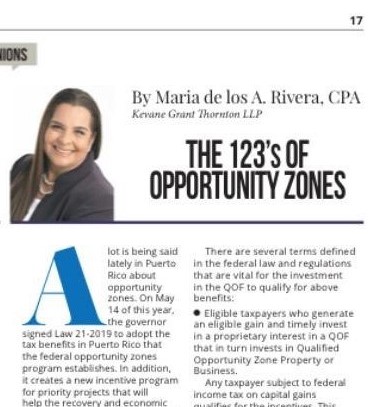-
Financial statements audits
Financial statement audits
-
Compliance audits
Compliance audits
-
Compilations and reviews
Compilations and audit
-
Agreed-upon procedures
Agreed-upon procedures
-
Tax compliance
Business Tax
-
Global mobility services
Through our global organisation of member firms, we support both companies and individuals, providing insightful solutions to minimise the tax burden for both parties.
-
Sales and use tax and indirect taxes
SUT/ VAT & indirect taxes
-
Tax incentives
Navigating the complex landscape of tax incentives in Puerto Rico can be challenging. Whether you're looking to benefit from the Export Services Act (Act 20), the Individual Investors Act (Act 22), or other incentives under Act 60, we provide tailored advice to help you maximize your tax benefits and ensure compliance. Let us help you unlock the potential of doing business in Puerto Rico.
-
Transfer Pricing
The laws surrounding transfer pricing are becoming ever more complex, as tax affairs of multinational companies are facing scrutiny from media, regulators and the public

-
Business consulting
Our business consulting services can help you improve your operational performance and productivity, adding value throughout your growth life cycle.
-
Business Risk Advisory
Risk is inevitable but manageable. We deliver relevant, timely and practical advices to aid organizations manage risk and improve business performance. We can help you identify, understand and manage potential risks to safeguard your business and comply with regulatory requirements.
-
Technology Advisory
We provide comprehensive solutions to safeguard your business and ensure operational resilience and compliance. Our expert team offers a range of technology advisory services designed to address your cybersecurity needs, enhance business continuity, and manage security effectively.
-
Transactional advisory services
Transactions are significant events in the life of a business – a successful deal that can have a lasting impact on the future shape of the organizations involved. Because the stakes are high for both buyers and sellers, experience, determination and pragmatism are required to bring deals safely through to conclusion.
-
Forensic and investigative services
At Grant Thornton, we have a wealth of knowledge in forensic services and can support you with issues such as dispute resolution, fraud and insurance claims.

Opinions, The Weekly Journal
A lot is being said lately in Puerto Rico about opportunity zones. On May 14 of this year, the governor signed Law 21-2019 to adopt the tax benefits in Puerto Rico that the federal opportunity zones program establishes. In addition, it creates a new incentive program for priority projects that will help the recovery and economic development of certain designated areas on the island. Before entering the discussion of Law 21, which was later included as part of the Incentives Code in Law 60-2019, in this first article, we will discuss the basics of the federal program, as they are essential to the local law enforcement.
Overall, the Tax Cuts and Jobs Act of 2017 created the Opportunity Zones program in the United States to attract investment and generate economic development in depressed areas. Puerto Rico is part of this program and by special disposition, a large part of the island has been designated as a qualified opportunity zone. So, how does the program work?
An eligible taxpayer generates an eligible gain and invests a similar amount in a qualified opportunity fund (”QOF”) and the income tax on the gain invested is deferred if the taxpayer keeps the investment for at least 5 years, he/she will only pay income tax on 90 percent of the gain. If kept for at least 7 years, only 85 percent of the gain will be taxed .The deferred gain must be recognized no later than December 31, 2026. The real benefit of the program is that, if the investment in the QOF is maintained for at least 10 years, the profit generated by the investment will be completely exempt from income tax.
There are several terms defined in the federal law and regulations that are vital for the investment in the QOF to qualify for above benefits:
- Eligible taxpayers who generate an eligible gain and timely invest in a proprietary interest in a QOF that in turn invests in Qualified Opportunity Zone Property or Business.
Any taxpayer subject to federal income tax on capital gains qualifies for the incentives. This includes individuals, corporations, partnerships, trusts, estates and others. Eligible gains are short-term or long-term capital gains and any gains that receive capital gain treatment. Eligible taxpayers have 180 days including the day on which the gain is realized to invest an amount equal to part or all of the gain in a qualified opportunity fund (”QOF”). The QOF must be a domestic entity for United States tax purposes (including entities created in Puerto Rico) that is treated as a corporation or partnership. The QOF must invest in property in the qualified opportunity zone.
The main purpose of the program is to attract investment to designated areas, so QFOs must maintain at least 90 percent of the assets contributed by investors in qualified property:
- shares, issued after December 31, 2017, of corporations operating a business in the QOZ,
- interest issued after December 31, 2017, in partnerships operating a business in the QOZ or tangible property used in the QOZ.
The law and regulations lay down additional requirements for businesses operating in the QOZ and for the property used in these businesses. These, like the incentives included in Law 21- 2019 will be explained in the following articles in this series.

